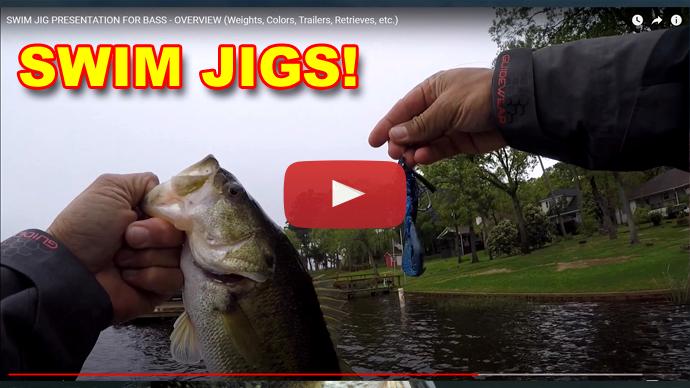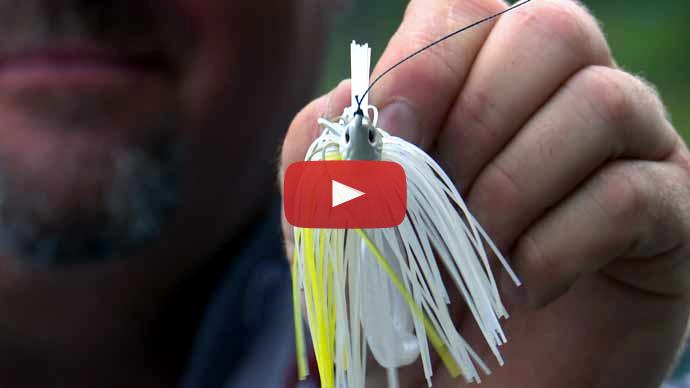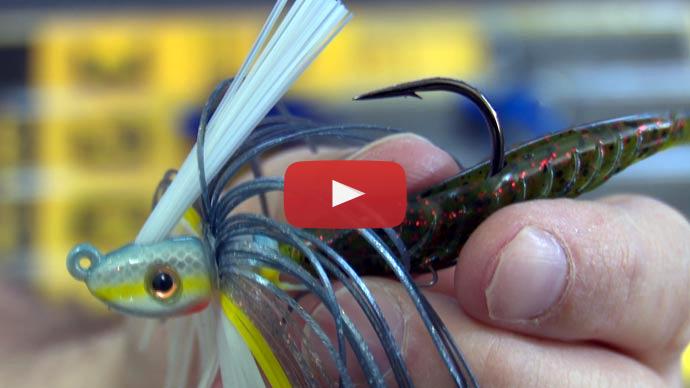Hi, guys. Wes Logan here with BassResource. We're going to be talking about swim jigs in wintertime. And a lot of...you know, if you ever read a article in "Bass Magazine," or anything like that, you're never probably going to hear those two words put together, is swimming a jig and the wintertime. But there is a few situations where if it happens around your local area, you need to go check it out because it could end up being really special, and you'll be able to catch some fish in the wintertime that haven't been pressured, and it'll really be a special day because I've had them, I've experienced it.
And, basically what that is, is you're in the wintertime, and you're talking about from, you know, mid-November to probably the end of February, maybe even into the middle of March, just depends on what kind of winter we've had that year, if we're going to have an early spring, or where you're at in the country.
And what that being said is, most of the time in the wintertime, I feel like your water temperatures are going to be in those low 40s the majority of the time. But what happens every now and then is you'll get, you know, a week or two, and it may be only a couple of days, where you'll get on a warming trend, or you'll have a warm rain, you know, come in, and have a bunch of run in come in. And what that does is it's going to muddy up the river, if you're on a river system, it'll muddy up a lake, whatever it's going to happen. It's going to muddy, and then, when the sun finally does come out, the particles in that mud and the water actually warm up faster.
So, the water's going to bump up a few degrees. And I'm telling you guys, any time in the wintertime when that water bumps up 2 or 3 degrees, you need to go, and, you need to go into a shallow area, not really fish your, you know, main lake bluffs, your rocky banks that hold heat. You're going to be able to still catch fish there. But if you ever get a rise in that water temperature, you need to check some shallower areas. And I'm not saying go all the way in the back like you would in spring spawning situation, but maybe 100, 200 yards back into a pocket, or a little backwater. Those fish may get out of that current, or off that main drag, or off the main lake, and pull up there because with that water rising, all the bait fish, the crawfish, everything up shallow's going to get active for a few days. And those fish know that.
So, when they feel that, and they've got that internal timer, they know that it's wintertime, they're not near spawning. But when they feel that water temperature bump up, they're like, "I can run up there and eat for a little while until it starts cooling back off," and, you know, have easy pickings of stuff that hadn't been messed with in a while.
So, with that being said, when you come in in these backwaters, let's just say, for instance, we've got, you know, some bank grass. And all the grass is going to be dead. You might have some bank grass mixed in with some whatever, some branches, some logs, some bushes, anything like that, those fish are going to go to that hard cover because the water's still cold, mind you. It may have just went from 42, 43 to 48, 47, 49. So, you've got an increase in temperature, but those fish are still going to be a little bit lethargic, and water's probably going to be a little bit dirty, or they're going to be on something, whatever's in the water. Like I said, that first 100, 200 yards, or 200 feet, however big or small the backwater is, is where you want to be checking.
And what you want to do is, I mean, you just going to take that swim jig and, like, in all my other videos, and what I throw all the time, most of the time is the 5/16 Dirty Jigs No-Jack. Color-wise with that, most of the time in the winter, the water is dirty. When, you know, the warm rain comes in, you're going to have some stained water. I really, really like a dark color, a black and blue, or solid black, a black and purple, whatever your preference may be. That's just my comfort. That's my number one that I'm going to go to, to start with. If I feel like there's more shad or whatever type of baitfish you're around in the area, that's when I'll swap over. Or if I've started with the black and I've had a few roll on it and not really commit to it, like they're showing themselves but they're not really eating the bait, that's when I'll swap to a white. Hardly ever in the wintertime will I be throwing a natural color. I just feel like the white or black is hard to beat. And, that goes into, even on into the springtime. But for the wintertime situation, you know, I like the dark color to start with.
And I like the big trailer. I like the Zoom Super Speed Craw. I feel like it moves a lot of water. I don't bring the jig in very fast, so it's kind of lethargic. It's kind of just bouncing around on stuff. It's a really good. I wouldn't say it's a great search bait in the winter, but when you have those conditions, it can be really special because if you see where you think one should be, and you throw over there, and you actually get the bite, now you can make a mental note, like, that fish was beside a log, 100 feet inside a pocket. You can pattern those fish very well with this swim jig pattern in the wintertime if you have a warming trend going on.
Rod and reel and line set up, it's a 7'6" medium-heavy. It's a medium-heavy, but it really acts a lot more like a medium. It's got a good parabolic bend to it. I like...the Ark Reinforcer is the one I use, and like I said, it's a 7'6" medium-heavy. It's a little bit longer rod than a lot of people like to use. If you like a 7'3", go throw a 7'3". If you like a 7'2", throw a 7'2". But my personal opinion and preference would be a medium-heavy, or a real, you know, flexible heavy. I'm kind of wary on the heavies just because their backbone runs so far up and you don't have a lot of tip when that fish does commit to the bait. Line is a 60-pound Sunline Fluorocarbon FX2. The frogging and flipping, that's just, it's my bread and butter when I've got the 5/16 No-Jack.
Reel is a 7.5:1 gear ratio. The reel I like to use is a Lews Pro-Ti. I mean, my personal opinion on the reel is if you like an 8 gear ratio, throw an 8. If you like a 7, throw a 7. I would not go below a 7 with this technique just because you want to be keeping that jig up. And again, you don't want to bring the jig back to you fast. You just want to be able to keep it up and keep it moving around the cover to be able to get those reaction strikes and stuff like that. So, if you like an 8, throw an 8, if you like a 7, throw a 7, but I wouldn't go below a 7. And that 7.5:1 Lews Pro-Ti has worked perfect for me.
And just want to reiterate on how I work the jig when I throw it around the cover. If you've got some, you know, a wad of blown-up dead matt of grass beside a log, you want to throw it past it. Keep your jig...like, as soon as your bait hits, engage the reel, keep your rod up, bring the jig towards or down the edge of the clump. You get it up there, kind of let it fall a little bit, then, you know, shake it a little bit. And once you do it for a while, and you get a few bites, you'll figure out if the fish want, you know, the reel up high if they're hitting it on the fall. Just, kind of, let them tell you what they want.
One thing I will...I just thought about it. One thing I will say about wintertime swim jigging is if you've got...let's say you've got a grass mat that's, you know, 2 feet by 4 feet, and you swim down the right side of it and don't get a bite, you need to throw over the top of it, and you need to throw down the other side of it. Because, a lot of times, with the water being that cold, he's not going to run a long way to go get it. He don't want to exert all that energy because he's just sitting there. He's wanting to eat, but he's not going to swim 10 feet to eat something. He's going to wait until he's got an opportunity to eat something right in front of him so he don't exert a lot of energy getting him something to eat because it's basically pointless then. He's not going to be running around school and all that good stuff.
So, really pick apart your cover options. Like, if you're...just one more for instance. If you're throwing at a lay down, throw down the right side and throw down the left side. And a lot of times, you'll notice that your second or third cast is something you'll actually get one to bite. And most of the time I feel like that's when you've actually brought that bait into his smaller strike zone, which is what you're going to experience in the wintertime.
But going back on everything, wintertime swim jigging, if you look at the forecast and you've got a warm rain coming, or if you've just got a warming trend with some real sunny days, don't be afraid to get up there shallow in that dirty water in a few backwaters. It could really lead to a great day. Hope this helps, and good luck to you guys.
BassResource may receive a portion of revenues if you make a purchase using a link above.



